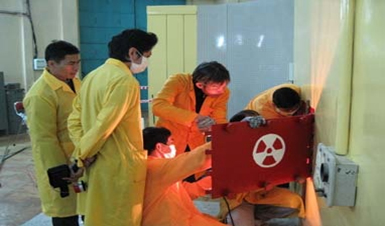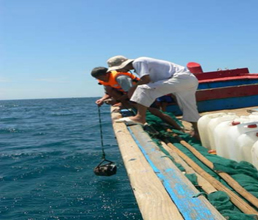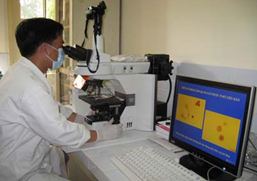MAIN ACTIVITIES AND ACHIEVEMENTS IN R&D
1. Dalat Research Reactor is a light water moderated and cooled, pool- type reactor using 19.75% enriched UO2-Al dispersion fuel. Its maximum thermal power is 500 kW. The DRR is used for radioisotope production, neutron activation analysis, fundamental and applied researches, and manpower training. By the end of 2018, the DRR had been safely operated and effectively exploited for a total operation time of about 46,000 hrs and with an accumulative released energy of about 860 MWh.
During the past ten years, some reactor technological systems were successfully renovated, including the replacement of reactor control and protection system, the partial core and full core conversions of the reactor from HEU to LEU fuel, the upgrading of the physical protection

Reactor re-start with LEU fuel in control room
system, the installation of area radiation monitoring system, the removal and transportation of fresh and spent HEU fuel assemblies back to Russian Federation, etc. The studies on reactor physics, thermal hydraulics, and safety analysis of the DRR, both for theoretical calculations and experimental measurements, were carried out. The calculation for partial and full core conversions of the DRR has been performed in the collaboration with the Argonne National Laboratory of DOE/USA. Besides, researches on conceptual design of a new multi- purpose research reactor have also been realized in the co-operation with KAERI of Korea.
2. Research and production of many kinds of radioisotopes and radiopharmaceuticals used in medicine and other areas have been successfully performed. On an annual basis, it is possible to provide about 400 Ci of radioisotopes for medical use, of which the main products are 131I solution and capsule, 99mTc generator, 32P applicator, 32P, 51Cr, 153Sm, etc., solution, labeled kits in-vivo for 99mTc, kit in-vitro T3, T4, etc. Each year, about 500,000 patients have been diagnosed and treated by radioisotopes supplied by DNRI. Other radioisotopes and radioactive tracers for sedimentology study, oil field, and industrial applications, such as 46Sc, 192Ir, 198Au, etc., have also been produced and distributed to end-users.
 |
 |
| Hot cell and I-131 production line | Products of Radioisotopes and Radiopharmaceuticals |
3. Neutron filters have been made and assembled at horizontal channels of the reactor to form thermal and quasi-monoenergetic neutron beams, such as 2keV, 24keV , 54 keV, 59 keV, 133 keV,148 keV, etc. The nuclear spectroscopy systems have been installed at 3 horizontal channels No. 2, No. 3 and No. 4 of the reactor, and specialized softwares have been developed for data processing. These beams have been used for measurements of nuclear reaction data and nuclear structure data based on (n,g), (n,2g) and (n,3g) reactions. They also have been utilized for prompt gamma neutron activation analysis, measurement of neutronporosity in base-rock for oil fields, irradiation of electronic components for radiation hardness study, study of Boron neutron capture therapy (BNCT) technique, etc. In addition, the neutron irradiation of gemstones in the reactor core, in the rotary rack outside the core, as well as in the horizontal channels for coloration experiments has also been carried out.

Assembling neutron filters
4. Analytical science has been studied and developed in a variety of techniques including nuclear and physico- chemical methods. A combination of different techniques comprising instrumental neutron activation analysis (INAA), radiochemical neutron activation analysis (RNAA), prompt gamma neutron activation analysis (PGNAA), X-ray fluorescence analysis (XRFA), and physico-chemical methods with HPLC, LSC, AAS, ICP- MS, GC, IC, UV-vis, etc., systems has made DNRI become a complete center providing analytical services for the South-eastern region and the Central Highlands in particular and the whole country in general. So far, these techniques may be used to accurately analyze up to 70 elements and constituents in various samples of geology, crude oil, agriculture, biology, environment, archaeology, etc. Each year, DNRI analyzes more than 6,000 samples using the above mentioned techniques. Additionally, K0 - method for INAA has been successfully established to analyze airborne particulate samples in investigations of air pollution, samples of crude oil, samples of base rock in oil field study, and archaeological samples as well.
 5. Environmental radioactivity research and monitoring have been carried out since DRR was put into operation. Radioactive concentration in the air, fallout, surface water, underground water, waste water, surface soil, sediment, vegetation and food has been monitored periodically. Up to now, about 17,000 environmental samples have been collected, analyzed and stored. DNRI is managing three monitoring stations located in DRR area, in Ho Chi Minh City and in Ninh Thuan province. Since 1997, the station at DNRI has become a national environmental monitoring station. Researches on marine environmental radioactivity have also been carried out during the last ten years. These researches will play an important role in the evaluation of impacts on environment of activities related to nuclear power plans.
5. Environmental radioactivity research and monitoring have been carried out since DRR was put into operation. Radioactive concentration in the air, fallout, surface water, underground water, waste water, surface soil, sediment, vegetation and food has been monitored periodically. Up to now, about 17,000 environmental samples have been collected, analyzed and stored. DNRI is managing three monitoring stations located in DRR area, in Ho Chi Minh City and in Ninh Thuan province. Since 1997, the station at DNRI has become a national environmental monitoring station. Researches on marine environmental radioactivity have also been carried out during the last ten years. These researches will play an important role in the evaluation of impacts on environment of activities related to nuclear power plans.
Environmental monitoring station at DNRI

6. The radioactive tracer techniques have been developed and applied successfully by DNRI. The artificial radiotracers, such as 46Sc, 192Ir, 198Au producted in DRR have been utilized for studying sediment dynamics in coastal and estuarine zones. The environmental radioisotopes (7Be, 137Cs, 210Pb, nuclides in Uranium and Thorium chains) have been applied in studies of environmental processes such as soil erosion, sedimentation rates, sediment sources, residence time and diffusion coefficient of coastal water, etc.
Surface sediment sampling at a coastal zone
7. DNRI has succeeded in the research and development of radiation technology for the preservation of food, sterilization of medical devices, and modification of materials. The research results on radiation technologies at DNRI have laid scientific-technical foundation of the establishment of irradiation centers on an industrial scale in Vietnam.Radiation technology has also been utilized for production of various plant growth promoters,plant protectors, etc. In recent years, biological environmental products have also been studied using radiation technology.
 |
 |
|
Cobalt-60 “Issledavachel” and “GAMMA CHAMBER -5000” irradiators |
Products serving agricultural |
| 8. Researches in the field of radiation biology and biotechnology consist of different studies on biological dosimeter, radiation safety health care, and environmental toxicology safety using the techniques of animal cell culture and of analysis of chromosomal aberrations; on plant mutation breeding, radiation hormesis, clonal propagation, and germplasm preservation using the techniques of plant in-vitro culture; and on the exploitation of gamma-rays induced microorganism mutants for certain sustainable use in agriculture, aquaculture and waste management technology. A minor line of applied research is the in-vitro culture and the production of several edible and medicinal fungi. |
Plant in-vitro culture lab |
|
Chromosomal aberrations scoring by flouresence microscope |
|
9. Some methods for radiation dose measurement and control have been successfully developed . The thermo - luminescent dosimeter (TLD) and the optically stimulated luminescence (OSL) dosimeter have been set up for use in personal dose control. Every year, DNRI provides the personal dose monitoring service for nearly 5,000 radiation workers in about 500 radiation organizations in Vietnam. Apart from that, DNRI has also safely treated and managed radioactive wastes, either in liquid or solid forms, which has been generated through the operating of itself or from other radiation organizations in Vietnam.
|
Personal dosimeter |
| 10. In the field of nuclear electronics, DNRI is capable of maintaining many types of electronic equipment, including the reactor I&C system. At present, the emphasis is on the design and construction of computer- based nuclear spectrometers using digital signal processing (DSP), and field programmable gate array (FPGA) techniques for the fundamental and applied studies. It is our supply of cost-effect, nuclear electronic equipment has contributed to pushing the development of nuclear medicine and industry applications in Vietnam. |
Data logging system |
11. DNRI has played a very important role in the reinforcement of material and technique potential, manpower development, enlarging the market for applications of nuclear technology and science, taking part in the program of introducing nuclear power for electricity production into Vietnam. Manpower training for the DNRI and for nuclear energy programme of Vietnam in the near future is one of the main tasks of DNRI.
12. Apart from scientific activities as described above, DNRI also takes responsibility for:
- Providing the public with nuclear science information and introducing them to different activities of DNRI and VINATOM.
- Organizing national and international workshops.
- Compiling nuclear science syllabi.
- Tutoring students of different levels, e.g. high school, and post graduate students
- Performing domestic/international cooperation on nuclear science and technology.
Along this line, DNRI has enthusiastically taken part in various national science and technology fairs and exhibitions, and has successfully co-organized different training courses (on the use of nuclear techniques in industry and environment, nuclear reactor engineering, radiography test, ultrasonic test, etc.) with other foreign institutions and organizations, (e.g. JAEA of Japan, BARC of India, DOE of USA, etc.).

Meeting of the Regional Advisory Safety Committee for Research Reactors
in Asia and the Pacific

Signing ceremony of the cooperation agreement between Most and Rosatom
in training Vietnamese staff for CNEST





 Thông báo về việc Thay đổi số tài khoản ngân hàng
Thông báo về việc Thay đổi số tài khoản ngân hàng 





